San Remo Coastal Circuit / Coastal Walk

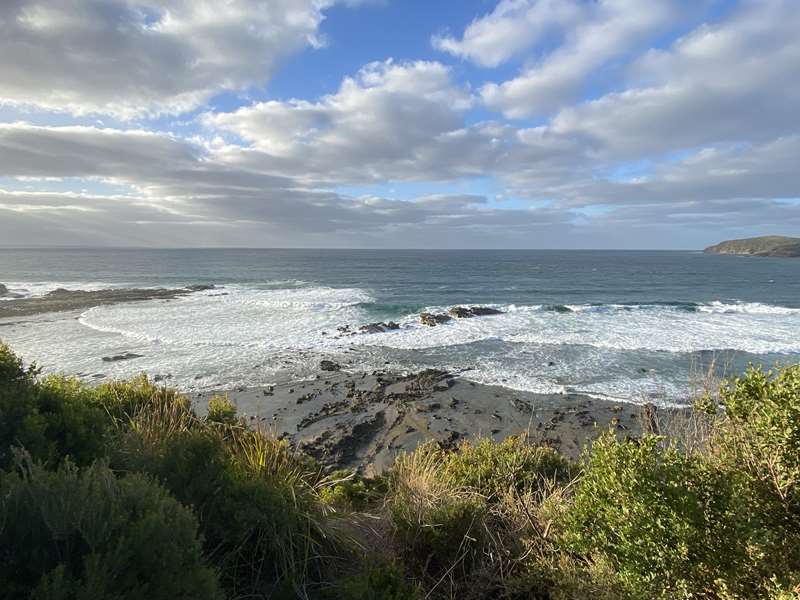
See the sights of San Remo. A scenic coastal track with spectacular views of Cape Woolamai, the bridge to Phillip Island and Western Port, the San Remo Coastal Circuit curves around Davis Point and follows the length of Children's Beach and Back Beach.
During the San Remo Coastal circuit, you can opt to walk through San Remo (and perhaps enjoy a coffee or lunch while you're there) or continue along the coast and enjoy the views.
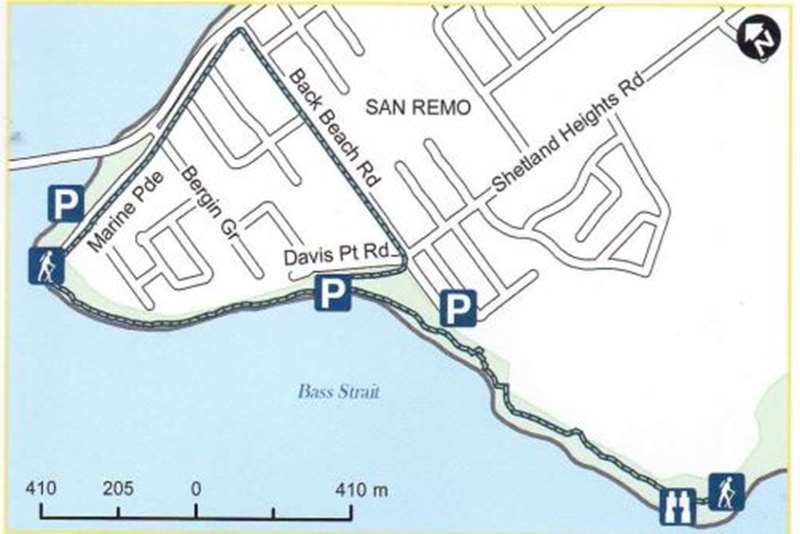
- Circuit walk: Loop 2.5km / 40 minutes return
- Coastal walk: 4km return / 1 hour return
- Easy rating
- Surface is gravel, sand, stone, beach, stairs and concrete path
- Parking at San Remo Foreshore car park (sealed), Marine Parade, San Remo. Also car park (sealed) Corner of Ocean Grove and Davis Point Road, San Remo and car park (unsealed) at Lions Park, Back Beach Road, San Remo
- Designated Accessible Parking at San Remo Foreshore (sealed), Marine Parade, San Remo
- Toilets at San Remo Foreshore car park and Lions Park, Back Beach Road San Remo
- Designated Accessible Toilets at toilet locations listed above
- Wheelchairs are unsuitable except for Marine Parade and Back Beach Road
- Prams are unsuitable except for Marine Parade and Back Beach Road
- Bicycles are unsuitable except for Marine Parade and Back Beach Road
- Picnic table/BBQ
Access for Dogs:
Dogs permitted on leash between 10am - 6pm between 1 Dec and 31 Jan each year and during Easter school holidays.
Dogs allowed off leash at all other times if the owner of the dog
- carries a leash
- has effective voice control of the dog at all times
- is able to place the dog under effective control by means of a leash immediately if necessary
- does not allow the dog to rush at or attack a person or animal
- always keeps the dog in sight
Review:
A lovely walk with spectacular views from the cliff tops. The southern section along the beach and then the cliff top to Foots Lookout is definitely the best part of the walk so we would strongly recommend doing the longer coastal walk rather than the circuit walk.
Be careful where you park in San Remo because there are one and two hour parking areas near the foreshore and shops from 9 am to 5 pm. This area has toilets, a playground, shelter with BBQ and two tables, four unshaded tables, water tap and pelican feeding at midday.
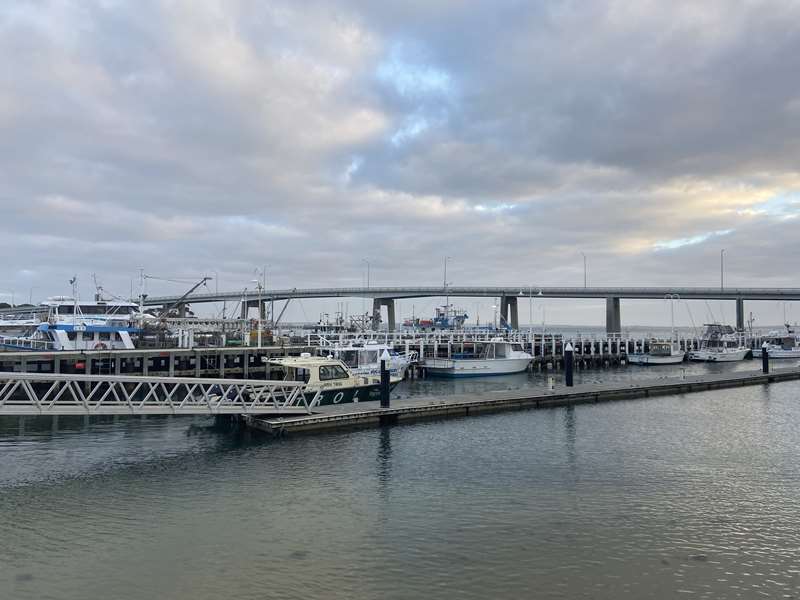
Go past the San Remo jetty, where there are lots of boats moored. Lookout for the 'Australian Pelican' which is an interactive artwork about bottle top marine debris.
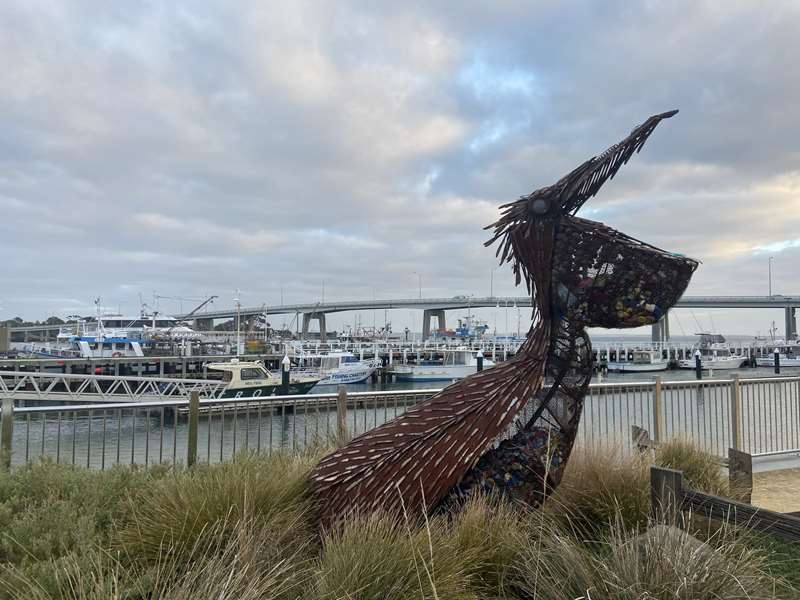
The first part of the trail has a number of information signs about the history of the port of San Remo. The track runs above the beach. Please do not swim here at The Narrows because it is a very fast running water and very dangerous.
Eventually the sandy path peters out and you walk along the beach with high cliffs on the left side. As you approach the headlands there are two wooden staircases up from the beach to the cliff top. The first staircase goes up to a grassy area with three unshaded tables and a George Bass memorial which is located at the southern end of Back Beach Road.
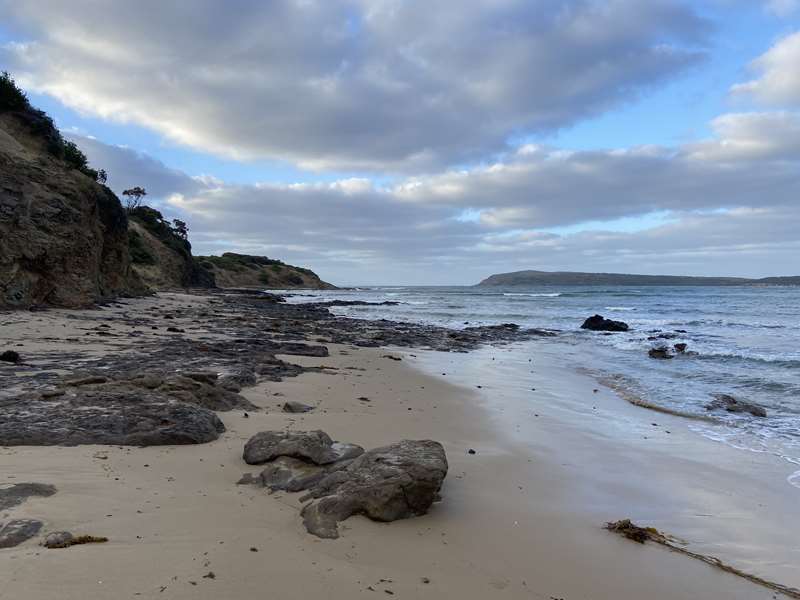
The other wooden staircase goes to the top of the cliff from where you follow a gravel path along the cliff until the path reaches a dead end where you can see the waves crashing below on a wide rocky beach. This is Foots Lookout. There is a path along the cliff linking the top of these two staircases.
There are seats along the path in a few places. The route be very exposed and windy so make sure you've got suitable clothing irrespective of the time of the year.
Information Signs Along Walk
Looking Back
You are standing on the traditional lands of the indigenous Bunurong people. People of the Bunurong's 'Yalloc Bulluk Beek' clan visited San Remo in the warmer months when food was plentiful.
They hunted kangaroos, possums, Short-tailed Shearwaters (muttonbirds) and fish. They also gathered shellfish and plants such as kangaroo apple and wild berries.
In 1798, English explorer, george Bass entered and named the bay Western Port. It was the 'western most port' he had noted. Once charted, survey vessels, sealers and whalers came into the area. There was initial contact with the Bunurong at nearby Bass River in 1802 and life for the first people changed forever.
Many fell victim to disease and women were taken away by sealers. Official settlement occurred in 1834 and by 1856 those surviving were moved to 'Mordy Yallock' known today as Mordialloc.
Today the Bunurong community works with the San Remo community to protect their proud heritage.
A Fishing Village
Fishing has always been a part of life in San Remo - Originally locals fished the rich waters to feed their own families. When they were able to transport their catch to Melbourne markets via rail, San Remo's commercial fishery blossomed. The industry began with catches of King George whiting.
San Remo had a bustling fishing industry in it's heyday - At any one time, there would be 50-60 boats moored at the jetty. This included 40 Couta boats, six or seven long-line boats and several cray boats. Imagine the activity as the catch was unloaded into crates, hauled up onto the jetty and wheeled along rail tracks into the nearby cold store. There the fish would await transport to Melbourne.
Fisherman's Cooperative - After World War 2, local fishermen returned home and established the San Remo Fisherman's Cooperative in 1948 with the support of government. Today fishing boats, recreational craft and a small commercial fleet, still operate from the San Remo jetties and the cooperative that runs for the benefit of the fishermen, is still going strong.
A special tribute - The rise in commercial fishing led to a tragic toss of life. Visit San Remo's memorial cairn dedicated to those who have lost their life at sea. You can find it in the reserve back along marine Parade towards San Remo township.
The Port of San Remo
In 1840, a deepwater port was established here at what was originally known as 'Griffiths Point' - A jetty was built to service the port and allow wattle bark, farm produce and cattle to be transported to Melbourne. The discovery of coal in the surrounding area led to a second coal jetty being built in the 1860s.
In those early days, bullock wagons delivered coal from Kilcunda to the waiting boats.
In the 1870s, a privately-owned, gravity-fed wooden tramway was constructed to deliver cool directly from Kilcunda. It was taken onto the coal jetty and loaded onto cargo ships bound for Melbourne. Horses then pulled the empty trolleys back to the mine.
By 1875, 8000 tonnes of coal had been transported through this port. The wooden tram tracks were replaced by steel and the first steam locomotive rolled into town in 1883. A town grew up around the port and was named San Remo, after the the resort town in Italy. By the late 1880s, the coal company closed. The rails on the Kilcunda line were lifted in 1898. A third jetty was built to access an enclosed bathing area for ladies.
Crossing the Narrows
The treacherous waters in front of you are known as The Narrows - This stretch of water between San Remo and Phillip Island is extremely fast moving as the tides rise and fall. The water rushes through this narrow channel between Western Port and Bass Strait at 5-6 knots.
Bunurong people would swim across the channel or cross in bark canoes. Early Europena settlers initially rowed across from San Remo to Newhaven on Phillip Island. Stock were walked over at the turn of the tide when the waters were calm.
In 1929 a two-car punt operated to connect San Remo and Newhaven, and was followed by a six-car punt in 1938.
The first bridge to Phillip Island was declared open in 1940. This two-lane suspension bridge was replaced by the current bridge in 1969. This bridge makes crossing the Narrows an easy and safe task and those early adventures are now a distant memory.
Photos:
Location
133 Marine Parade, San Remo 3925 Map











